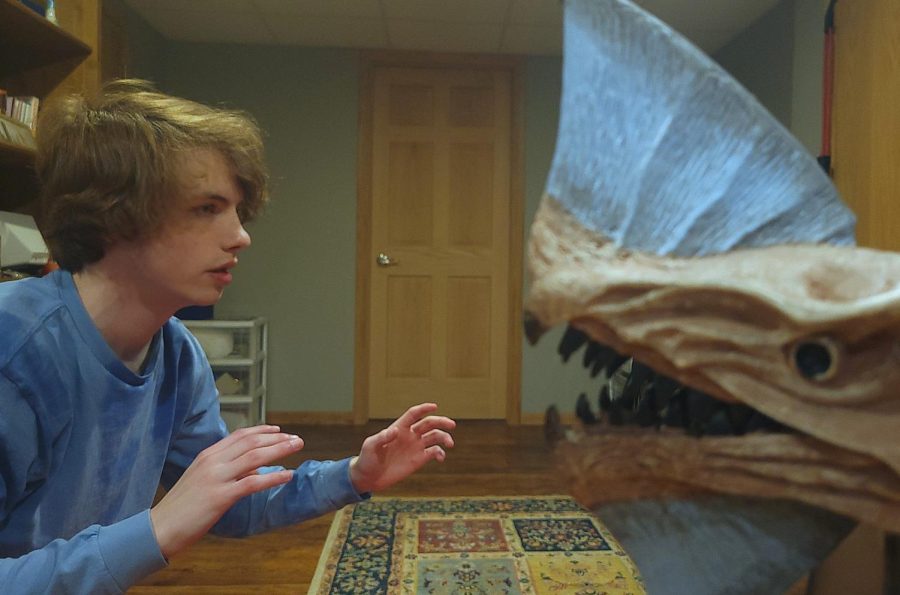Opinion: Practical Effects Need to be Considered in Modern Films
“Forced perspective” is a common practical effect, in which objects are placed nearer to or farther away from the camera to make them appear to be a different size then they actually are.
February 3, 2023
For much of the history of film, every shot of a movie had to actually be physically filmed. However, this did not mean every shot had to be completely real. Movies utilized practical effects, visual tricks physically produced for film, to bring their scenes to life. The original “Star Wars” trilogy extensively used practical effects: a model of the Death Star was built and actually destroyed, hidden mirrors were used to make Luke’s landspeeder look like it was actually floating and the Battle of Hoth used miniature models.
When science fiction movie “Westworld” first used Computer Generated Imagery in 1973, no one could have predicted how prevalent the technology would become. In the 1970s, CGI was far more modest than it is today. It was segregated mostly to the realm of computer displays in science fiction movies. The only computer generated element in the original 1977 release of “Star Wars” was a graphic for the Death Star attack briefing lasting under a minute. When “Jurassic Park” launched the film world into the realm of CGI in 1993, it used just 15 minutes worth of CGI dinosaurs.
Compare this far humbler usage of computer effects to the CGI in modern blockbusters. Entire worlds are created with CGI and actors in the same movie never have to actually see each other in person. In “Avatar: The Way of Water,” the world of Pandora was brought together almost entirely using CGI and most of the Marvel movies that dominate the box office feature grand battles between computer generated heroes and villains. In many productions, CGI has come to replace practical effects, but is that the best direction for film?
A greater focus on CGI can undeniably make production safer for all involved. Using computer generated firearms instead of real ones would reduce the risk that an actor is injured, a notion that has become more popular after the deadly shooting that took place on the set of “Rust.”
To avoid harming any real animals, they can be replaced by CGI animals, which they did entirely in the 2022 Telugu epic “RRR.” This choice also gave director S.S. Rajamouli more freedom over what he wanted to do in scenes involving animals.
On the other hand, certain aspects of practical effects are simply more convincing. No matter how good CGI is, the audience knows what they are looking at is not real and the actors there did not actually see anything.
Part of the satisfaction of the 1975 classic “Jaws” comes from the impressive 25-foot long mechanical sharks used in the movie; the movie would not have had the same impact if the shark was not real. The actors are seeing a massive, terrifying shark in real life.
While many shots in “Jurassic Park” used CGI dinosaurs, even more of them used practical effects in the form of puppets and sculptures to bring the dinosaurs to life. The actors were actually interacting with intricate models of the dinosaurs, and this captivated audiences. Having the actors actually be in the presence of physical models of the dinosaurs is honest and convincing in a way that an actor yelling at a green screen could never reproduce. When I had first watched “Jurassic Park,” I definitely found the CGI elements to be cool, but it was the practical effects like the shockingly real puppet triceratops and frightening scenes of practical velociraptors that drove the film home for me.
The CGI monsters used in the modern “Jurassic World” franchise lack the same authenticity. They do not feel like real dinosaurs that have been brought back to life, they feel like fantasy creatures made for mindless entertainment. The newer CGI dinosaurs may look more realistic than one of the original practical puppets, but they are still far less convincing.
Furthermore, it is far more difficult for actors to act when the environment, the monsters, or even the other actors they are supposed to be interacting with aren’t actually there. If an actor does not know what the alien supposedly chasing them looks like or even where it is, how are they meant to know how their character would respond?
Practical movie monsters can always be enhanced later by the addition of computer generated elements, while still giving the actors something to interact with in the moment. Film should look to using practical as a baseline while filming to improve the most important aspects of any film; the acting and the story.
Practical effects and stunts can also have more satisfaction than their computer generated counterparts. In “Top Gun: Maverick,” the cast members actually learned how to fly and performed many of their in-air stunts. I find this aspect of Tom Cruise’s movies to be what completes them. “Top Gun: Maverick” certainly would not have been a bad movie if all of the stunts had been completely computer generated, but it would not have been as impactful. The knowledge that these actors were actually racing through the skies made me feel much more connected to all of the hardships and achievements that their characters experienced while in the air.
Oftentimes, even productions that heavily rely on CGI need to look to practical solutions to solve their problems. “Avatar: The Way of Water” is known for its dedication to CGI with nearly all of the main characters being computer generated, but when faced with the issue of making convincing computer generated water, writer-director James Cameron did motion capture for the film under actual water. “RRR” extensively used CGI but still opted for practical fire as it would be more impactful for the audience.
Reliance on CGI often has the negative effect of allowing studios to mass produce their effects rather than carefully think them through. Marvel has received heavy criticism for a noticeable drop in quality of their recent visual effects, as scenes are sent to overworked visual effects artists to create CGI for their conveyor belt of movies and shows. Saying all Marvel movies follow a similar formula is no groundbreaking criticism, but it is absolutely a valid one and it needs to be acknowledged that CGI is an important factor in this formula.
It has become an expectation from Marvel directors that they will have the visual effects they want, it is no longer something they need to work on. While Steven Spielberg had to work with both practical and computer effects artists to carefully bring his vision for “Jurassic Park” to reality, director Taika Waititi recently insulted the work of computer effects artists on his movie “Thor: Love and Thunder.” The entitlement some modern directors feel towards having good CGI, beyond just being ridiculous, means that they do not work to solve visual issues they see in their films; like Waititi they simply throw the overworked effects team under the bus. Visual effects are no longer viewed as a part of the movie-making process, but something to be added in by a separate company after the fact. This results in both worse films and a toxic culture in the effects industry that has led to efforts to unionize.
Having to carefully consider how effects will be created, whether it be practically or digitally, means directors put more effort into each shot and the meaning behind it. This is what Spielberg did in “Jurassic Park,” making it one of the most iconic films of all time. Rajamouli did the same in “RRR,” making it a colossally successful film globally. While Spielberg settled on more practical and Rajamouli settled on more CGI, the consideration that both put into each method are an important factor in the quality and success of both films.
I am not advocating that we abandon CGI and return to practical effects, but the film industry needs to reconsider how effective practical alternatives can be. Practical effects are not inferior or obsolete and should not be erased from the catalog of tools at a director’s disposal.
The film industry needs to remember its roots in practical effects while still using CGI to enhance the practicals and ensure the safety of the cast and crew when necessary. This will allow for more convincing and meaningful movies to be made by bringing both new and old methods together.



